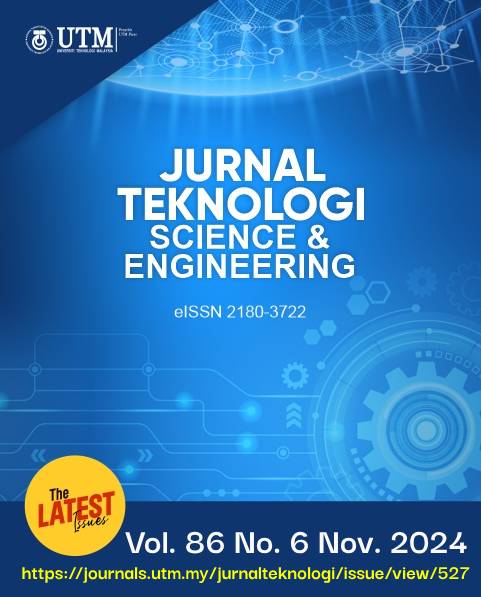AXIAL DEFORMATION OF SPINEBIO-TENSEGRITY MODELAT DIFFERENT DEPLOYABLE SCHEMES
DOI:
https://doi.org/10.11113/jurnalteknologi.v86.21028Keywords:
Biotensegrity, convergence curve, deployable, sequential quadratic programming, spineAbstract
The study presents the axial deformation of a spine bio-tensegrity model through a shape change strategy with different deployment schemes. The spine bio-tensegrity model mimics the total height, tapered form and natural curvature of a human spine. Three deployable schemes S1-S3 with a different combination of cables at alterable and fixed lengths (at the lower, middle and upper part of the model, respectively) were investigated to achieve a series of axial displacements at 200 mm, 400 mm and 600 mm in the z-direction. The shape change algorithm was developed to optimise the forced elongation of cables, incorporating an objective function designed for monitored nodes in the system to reach their prescribed targets during the optimisation process. Sequential quadratic programming was employed to solve a nonlinear optimisation problem in the shape change analysis involving inequality constraints. The efficiency of the deployable schemes was evaluated based on the deformed shapes, convergence curve and axial forces of the spine bio-tensegrity model. The finding shows in addition to axial deformation, the model in deployment scheme S1 preserves the slenderness characteristic of the spine. In contrast, the model exhibits excessive expansion in the thoracic region in schemes S2 and S3. Greater total computational steps in deployment scheme S3, followed by S2 and S1, reveal that the active cables set near the monitored nodes allow the model to sense and act faster to reach their targets. The study contributes to understanding the structural behaviour and deployment strategy for a structure mimicking a biological system.
References
Bauer, J., Kraus, J. A., Crook, C., Rimoli, J. J., and Valdevit, L. 2021. Tensegrity Metamaterials: Toward Failure‐resistant Engineering Systems through Delocalized Deformation. Advanced Materials. 33(10): 2005647. https://doi.org/https://doi.org/10.1002/adma.202005647.
Booth, J. W., Cyr-Choiniere, O., Case, J. C., Shah, D., Yuen, M. C., and Kramer-Bottiglio, R. 2021. Surface Actuation and Sensing of a Tensegrity Structure using Robotic Skins. Soft Robotics. 8(5): 531-541. https://doi.org/https://doi.org/10.1089/soro.2019.0142.
Busscher, I., Ploegmakers, J. J., Verkerke, G. J., and Veldhuizen, A. G. 2010. Comparative Anatomical Dimensions of the Complete Human and Porcine Spine. European Spine Journal. 19: 1104-1114. https://doi.org/http://doi.org/10.1007/s00586-010-1326-9.
Chai Lian, O., Kok Keong, C., Nishimura, T., and Jae-Yeol, K. 2020. Form-finding of Spine Inspired Biotensegrity Model. Applied Sciences. 10(18): 6344. https://doi.org/https://doi.org/10.3390/APP10186344.
Chen, B., and Jiang, H. 2022. Instability Results from Purely Rotational Stiffness For General Tensegrity Structure With Rigid Bodies. Mechanism and Machine Theory, 167: 104485. https://doi.org/https://doi.org/10.1016/j.mechmachtheory.2021.104485.
Hlavenka, T. M., Christner, V. F. K., and Gregory, D. E. 2017. Neck Posture during Lifting and Its Effect on Trunk Muscle Activation and Lumbar Spine Posture. Applied Ergonomics, 62: 28-33. https://doi.org/https://doi.org/10.1016/j.apergo.2017.02.006.
Ingber, D. E., Wang, N., and Stamenović, D. 2014. Tensegrity, Cellular Biophysics, and the Mechanics of Living Systems. Reports on Progress in Physics. 77(4): 046603. https://doi.org/http://doi.org/10.1088/0034-4885/77/4/046603.
Levin, S. M. 2002. The Tensegrity-truss as a Model for Spine Mechanics: Biotensegrity. Journal of Mechanics in Medicine and Biology. 2(03n04): 375-388. https://doi.org/https://doi.org/10.1142/S0219519402000472.
Liu, Y., Bi, Q., Yue, X., Wu, J., Yang, B., and Li, Y. 2022. A Review on Tensegrity Structures-based Robots. Mechanism and Machine Theory. 168: 104571. https://doi.org/https://doi.org/10.1016/j.mechmachtheory.2021.104571.
Oh, C. L., Choong, K. K., and Low, C. Y. 2012. Biotensegrity Inspired Robot–Future Construction Alternative. Procedia Engineering. 41: 1079-1084. https://doi.org/https://doi.org/10.1016/j.proeng.2012.07.286.
Oh, C. L., Choong, K. K., Nishimura, T., and Kim, J.-Y. 2022. Multi-Directional Shape Change Analysis of Biotensegrity Model Mimicking Human Spine Curvature. Applied Sciences. 12(5): 2377. https://doi.org/https://doi.org/10.3390/app12052377.
Oh, C. L., Choong, K. K., Nishimura, T., Kim, J.-Y., and Hassanshahi, O. 2019. Shape Change Analysis of Tensegrity Models. Latin American Journal of Solids and Structures. 16(9): 1-19. https://doi.org/http://dx.doi.org/10.1590/1679-78255407.
Plaut, S. 2023. “Long COVID-19” and Viral “Fibromyalgia-ness”: Suggesting a Mechanistic Role for Fascial Myofibroblasts (Nineveh, the shadow is in the fascia). Frontiers in Medicine. 10: 952278. https://doi.org/https://doi.org/10.3389/fmed.2023.952278.
Scarr, G. 2012. A Consideration of the Elbow as a tensegrity Structure. International Journal of Osteopathic Medicine. 15(2): 53-65. https://doi.org/https://doi.org/10.1016/j.ijosm.2011.11.003.
Swanson, R. L. 2013. Biotensegrity: A Unifying Theory of Biological Architecture with Applications to Osteopathic Practice, Education, and Research—A Review and Analysis. Journal of Osteopathic Medicine. 113(1): 34-52. https://doi.org/https://doi.org/10.7556/jaoa.2013.113.1.34.
Wang, Y., Xu, X., and Luo, Y. 2021. Minimal Mass Design of Active Tensegrity Structures. Engineering Structures. 234: 111965. https://doi.org/https://doi.org/10.1016/j.engstruct.2021.111965.
Wang, Z., Li, K., He, Q., and Cai, S. 2019. A Light‐powered Ultralight Tensegrity Robot with High Deformability and Load Capacity. Advanced Materials. 31(7): 1806849. https://doi.org/https://doi.org/10.1002/adma.201806849.
Yang, S., and Sultan, C. 2019. Deployment of Foldable Tensegrity-Membrane Systems via Transition between Tensegrity Configurations and Tensegrity-membrane Configurations. International Journal of Solids and Structures. 160: 103-119. https://doi.org/https://doi.org/10.1016/j.ijsolstr.2018.10.017.
Yıldız, K., and Lesieutre, G. A. 2020. Deployment of n-strut Cylindrical Tensegrity Booms. Journal of Structural Engineering. 146(11): 04020247. https://doi.org/https://doi.org/10.1061/(ASCE)ST.1943-541X.0002807.
Zappetti, D., Arandes, R., Ajanic, E., and Floreano, D. 2020. Variable-stiffness tensegrity spine. Smart Materials and Structures. 29(7): 075013. https://doi.org/https://doi.org/10.1088/1361-665X/ab87e0.
Zhu, D., and Deng, H. 2020. Deployment of Tensegrities Subjected to Load-carrying Stiffness Constraints. International Journal of Solids and Structures. 206: 224-235. https://doi.org/https://doi.org/10.1016/j.ijsolstr.2020.08.022.
Downloads
Published
Issue
Section
License
Copyright of articles that appear in Jurnal Teknologi belongs exclusively to Penerbit Universiti Teknologi Malaysia (Penerbit UTM Press). This copyright covers the rights to reproduce the article, including reprints, electronic reproductions, or any other reproductions of similar nature.
















